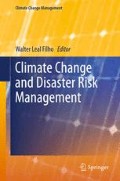Abstract
This article investigates the underlying forces that have led to the disastrous impact of recent extreme climate events in Mongolia and explores strategies to better deal with such events. In-depth field research was carried out following the 2010 extreme winter known as dzud making use of a combination of participatory research techniques, individual and focus group interviews, and surveys. The harsh winter of 2010 was one of the worst of its kind resulting in the death of eight and a half million livestock. In the last decade, this kind of extreme weather event has been on the rise. Herders have encountered serious difficulties in coping with them, preparing for them and mitigating their impact. Following the transition from a Soviet-dominated regime to democracy and a free market, pastoral livelihoods have become much more exposed to three interrelated forces: climate change and weather dynamics, natural resource degradation, in particular of grasslands and water, and rapid societal change. Co-management of natural resources is a form of collective adaptive management that reduces risks related to climate and societal change. Co-management could benefit from the timely delivery of improved weather forecasting, in particular on a local level. The scaling-out of co-management would benefit from stronger government support in terms of legal protection of new organisational forms, technical and financial support, and improved rural services. The results of this research deepen our understanding of the complexity of the forces that have made herding much riskier. It also opens a window to the benefits of co-management which the government of Mongolia aims to scale out nationally as a means to deal with climate change and related risks.
Access this chapter
Tax calculation will be finalised at checkout
Purchases are for personal use only
References
Enkhbat B (2010) Securing pastoralism in post-socialist Mongolia: Herders’ livelihood strategies in the context of climate change and market uncertainties. MSc thesis, Chiang Mai University, Chiang Mai
Fernández-Giménez ME, Batbuyan B (2004) Law and disorder: local implementation of Mongolia’s land law. Dev Change 35(1):141–166
Government of Mongolia and UNDP Mongolia (2009) National Strategy for climate risk management and action plan for Mongolia. Draft report, United Nations Development Program, Ulaanbaatar
Janes CR (2010) Vulnerability to climate change in Central Asia: Implications for food security and Health. Asia Pac J Public Health 22(3):236–245
Marin A (2010) Riders under storms: Contributions of nomadic herders’ observations to analyzing climate change in Mongolia. Glob Environ Change 20(1):162–176
Ministry of Nature, Environment and Tourism (2009) Mongolia: Assessment report on climate change 2009. Ministry of Nature, Environment and Tourism, Ulaanbaatar
National Statistics Office of Mongolia (2010) 2009 Mongolia statistical yearbook. National Statistics Office of Mongolia, Ulaanbaatar
Schulze A (2009) Land legislation and the possibilities for pastoral risk management and adaptation to climate change—the example of Mongolia. Food and Agriculture Organization of the United Nations, Rome
Swift JJ (2007) Case study—Institutionalizing pastoral risk management in Mongolia: lessons learned. Food and Agriculture Organization of the United Nations, Rome
United Nations Mongolia Country Team (2010) Mongolia: Dzud appeal. Ulaanbaatar, United Nations. Accessed at http://www.humanitarianappeal.net
Upton C (2008) Social capital, collective action and group formation: developmental trajectories in post-socialist Mongolia. Hum Ecol 36(2):175–188
Vernooy R, Wang X (2010) Climate risk management-technical assistance support project II: community profile Mongolia. United Nations Development Program and Regional Integrated Multi-hazard Early Warning System, Bangkok
Ykhanbai H, Enkhbat B, Ulipkan B, Vernooy R, Graham J (2004) Reversing grassland degradation and improving herders’ livelihoods in the Altai Mountains of Mongolia. Mt Dev Res 24(2):96–100
Ykhanbai H, Enkhbat B (2006) Co-management of pastureland in Mongolia. In: Tyler SR (ed) Communities, livelihoods and natural resources: action research and policy change in Asia, ITDG, Bourton on Dunsmore and International Development Research Centre, Ottawa, pp 117–128
Ykhanbai H, Odgerel TS (2006) Herder women speak out: towards more equitable co-management of grasslands and other natural resources in Mongolia. In: Vernooy R. (ed) Social and gender analysis in natural resource management: learning studies and lessons from Asia. Sage, New Delhi, China Agricultural Press, Beijing, International Development Research Centre, Ottawa, pp 181–206
Ykhanbai H, Narantulga B, Odgerel TS, Binye B, Vernooy R (2009) Unlearning old habits: an evaluation of CBNRM capacity development in Mongolia. In: Campilan D, Bertuso A, Nelles W, Vernooy R (eds) Using evaluation for capacity development: community-based natural resource management in Asia. International Potato Center-UPWARD, Los Baños, pp 221–242
Ykhanbai H (ed) (2011) Sustainable management of natural resources in Mongolia: a decade of experiences and lessons. Admon Publishing House, Ulaanbaatar
Acknowledgments
Research for this article was supported by the Regional Integrated Multi-hazard Early Warning System (RIMES), Bangkok, Thailand as part of the Climate Risk Management-Technical Assistance Support II project funded by the United Nations Development Program. The opinions expressed, are those of the authors only.
Author information
Authors and Affiliations
Corresponding author
Editor information
Editors and Affiliations
Rights and permissions
Copyright information
© 2013 Springer-Verlag Berlin Heidelberg
About this chapter
Cite this chapter
Xiaoli, W., Vernooy, R. (2013). Reading the Weather: Climate Risk Adaptation in Mongolia. In: Leal Filho, W. (eds) Climate Change and Disaster Risk Management. Climate Change Management. Springer, Berlin, Heidelberg. https://doi.org/10.1007/978-3-642-31110-9_42
Download citation
DOI: https://doi.org/10.1007/978-3-642-31110-9_42
Published:
Publisher Name: Springer, Berlin, Heidelberg
Print ISBN: 978-3-642-31109-3
Online ISBN: 978-3-642-31110-9
eBook Packages: Business and EconomicsEconomics and Finance (R0)

